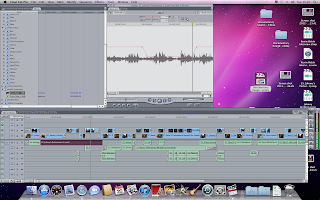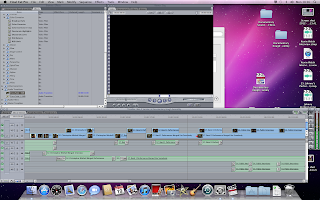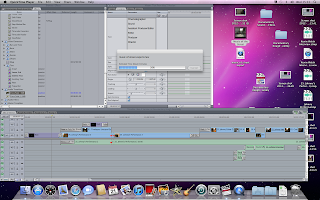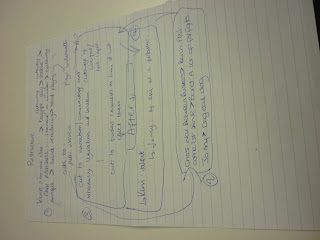This is a short film that takes a comedic look at two 'successful' alcoholics, who seem to be successful through work and having a nice car, etc but are actually alcoholics and don't recognise it in themselves until the end. There are a few funny scenarios that take a lighter view to whats happening but as the film progresses, the viewer see's just how bad they are.
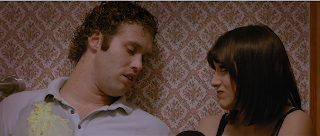
The shot about and the shot below are in the beginning sequence of the film and situates the viewer in how bad the two characters are but through the comedy of the sequence, the viewer knows that they are very drunk but they don't recognise the extent of the pairs problem with alocohol as the situation makes us laugh. At this point, we are in the same denial as the characters. A lot of this effect is created through the acting which is great. The first time I watched this, I thought the acting was very good on the part of the female protagonist but not on the males but having re-watched it, I think I gave him little credit on my first viewing although I still feel that she is the better actor.
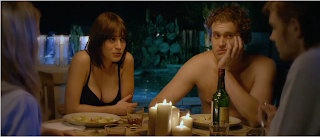
As the film progresses, we begin to see how much they drink, most of this is done through montaging shots together in quick succession in the same set-up. The picture below denotes their kitchen and although we aren't aware of it yet, the couple are about to go to work. The costume choice for him denotes that a little but because the shots of them drinking are in rapid succession, we think they don't have to be in work, so juxtaposing this with the scenes of them at work really hits home to the viewer just how addicted they are.
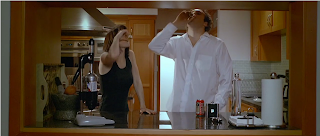
The mise-en-scene is very carefully chosen and this is apparent. There is always a drink around the couple for the most part of the film, the clothing for their characters are indicative of their success and in the case of the male protagonist, his varying states of drunk behaviour at work - his various co-workers and boss picking up on his state of attire during his working day. In his office at work, he has a calendar behind him with happy hours marked on most days, his bottom drawer is filled with spirits as we find out when he puts them on his desk and various objects line his desk which he obviously finds amusing in his drunken haze, as indicated by his interactions with these. Even in scenes that are chaotic and filled with objects that the pair have obviously strewn around in their drunken frenzies, objects are carefully placed such as the laptop in the sink for plot progression.

Although a lot of the drunken encounters are funny and portrayed in a comedic light, little juxtapositions between shots indicate that the situation is far from funny and indeed beyond what audiences would think were normal. Such as the scene where they are at a bar and exit onto a bright street, obviously mid-morning. The lighting of these shots are contrasting very clearly, the first shot is dark with obvious internal lighting that indicates a bar and the second shot is very bright and stark. The use of a bar instead of a home setting tricks the viewer because a bar is purposefully dark to keep people in for longer as they can't see a change in time through light changes and so the viewer automatically assumes it is night because it is a darker atmosphere. Pictured above and below are shots from this sequence that illustrate this point, the shot below is about to fade to white; the choice of fading to white instead of black separates time without the viewer automatically associating the black screen with a blackout that the characters might experience. Decisions like these show the directors intentions and consideration to the final piece.
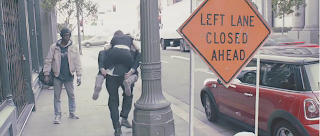
The shot below is a turning point where the female protagonist first realises that things are getting out of hand. The shot opens with the couple asleep on each other clearly in a car and then progresses to the arrival of a police man. There is some comedy in the exchanges between a clearly drunk protagonist and the police officer but a viewer can appreciate the gravity of the situation. By this point in the film, the audience are attached to the protagonists and so in this situation we want them to not be arrested but this puts us in a place of dilemma as we want them to not get in trouble but we also know that without getting in trouble, they won't know how bad their situation has gotten.
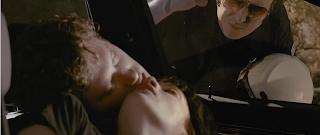
Overall, I think the film is successful as it carefully manipulates the viewer through comedic sequences and juxtaposition into empathising with the characters and therefore wanting them to realise that they are alcoholics. I think the ending is particularly apt and it sobers the audience's mood; this ending asks the audience to think about the film whilst connoting how hard it is to break alcoholism through the decision to not show the audience what has become of the male protagonist. We know that he probably hasn't been able to kick his habit but we don't know where that leaves him and the filmmaker has left us to think about that.










































